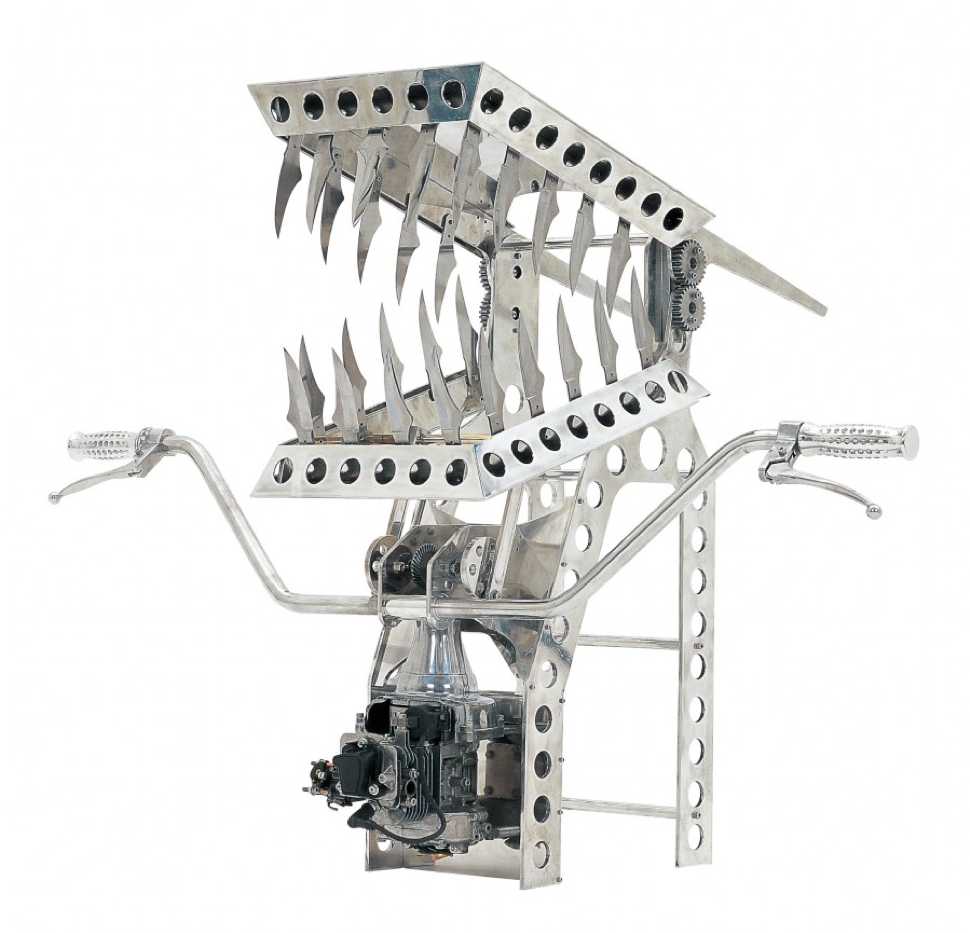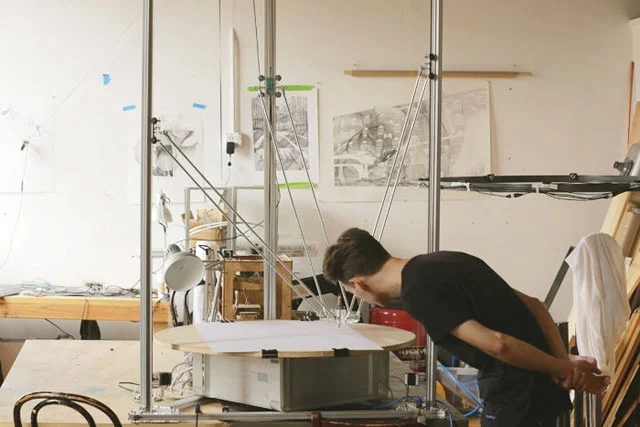Naki Series
Sei-Gyo, Na-Tate-Goto, and Uo-No-Me are three very interesting products that were imagined and produced by the Japanese group known as Maywa Denki in 1994 as part of their NAKI Series. In order to truly appreciate these unusual works of art, it is important for one to first understand the duo behind their production. Maywa Denki is a playfully unusual group of two artists—two brothers to be exact: Masamichi and Nobumichi Tosa. The duo, which was formed in 1993, is represented as a company in order to pay homage to the artists’ father and the small to medium sized businesses that had once supported Japan’s economy during its high-growth period. Complete with typical Japanese working uniforms, the group creates products rather than works of art and gives product demonstrations rather than live performances or exhibitions.
The products that make up the NAKI Series, much like many of Maywa Denki’s other creations, are considered “Nonsense Machines.” A term that lies at the middle of the group’s artistic philosophy and plays a large role in connecting their products to a larger conceptual intent; an intent that is beautifully represented in these specific works. Incorporating “nonsense” as a foundational element in one’s artistic practice may seem odd, but Nadine Botha describes why that might not be the case for Maywa Denki.
““Nonsense” is not a derogatory term in relationship to Tosa, in fact he claims it as his artistic imperative. It’s easy to interpret this as a response to the question of what does one make for a world that has everything? However, in speaking to him, Tosa refuses to give in to interpretation or social speculation, instead radiating the speculative power of nonsense.””
Tosa believes that “creativity is nonsense. And nonsense activities are the only solution to how modern society can evolve to the next stage.” Another interpretation of nonsense is chaos, a concept that is ever present in our world. It is a phenomenon that constantly arises before order. More often than not, a period of chaos must come before a deeper understanding and eventual return to equilibrium can occur. If one looks at the NAKI Series through this lens then all of the pieces are channels through which the audience or the user can experience an instance of chaos, gain a deeper understanding and return to equilibrium where they have the potential to move onto, as Tosa describes, the next stage.
The products that are part of the NAKI Series are some of the first created by Maywa Denki and served as an approach and attempt to answer a personal question for Tosa; “Who am I?” Subsequently, additional questions arose during the production process. Questions like: “What is God?”; “What is the world?”; “What is it to produce a thing?” Admittedly, these questions present a rather existential examination of oneself and one’s relevant connection to the universe. If one is to imagine oneself as a fish then that would be a mindset similar to that of Tosa when he was imagining these products; products that all contain an element of humor that makes them fairly approachable in comparison to works created by other contemporary artists.
According to Takuo Komatsuzaki, the curator of the Hiroshima City Museum of Contemporary Art,
““[There is] no need for difficult art theory or ideologies, their brand of very visual, easy-to-understand fun can be readily appreciated by all.””
Even though no theory or ideologies are required, it is still interesting when one starts to breakdown specific products in an attempt to get a deeper understanding. Three of the products from the NAKI Series are described below:
Courtesy of the artist | Source: http://www.maywadenki.com/products/NAKI/sei-gyo/
Sei-Gyo (Holy Fish in English) is a fish-controlled tractor. As the fish swims around in the cross-shaped water tank, which is equipped with four sensors, the tractor moves in the same direction as the fish. It is impossible to predict how the tractor will move as it is entirely controlled by the fish and as it moves back and forth the fish is jerked around, sometimes setting off additional sensors. The reason for the shape of the container, which is clearly a cross, is hard for one to decipher especially because only around one percent of the Japanese population claims Christian belief or affiliation. However, upon closer consideration of Tosa’s method for production in the NAKI Series, one can see that this product is to be considered from the point of view of God. The container then becomes a world for the human to observe the fish from a vantage point that is considerably more complex and potentially abstract.
Courtesy of the artist | Source: http://www.maywadenki.com/products/NAKI/na-tate-goto/
Na-Tate-Goto (Fish Harp in English) is an automatic electric harp in the shape of an elongated fish. The product features optional timing and as the fish’s head spins around, two picks attached to the fins strum the harp-strings. The fish’s eyes light up and as the head rotates it slightly resembles a lighthouse, which provides additional connection to the water-based environment of a fish. Along with the music created by the harp there is a typewriter-like sound created by the fins flopping in and out. This product was made from, as Tosa describes, the tool’s point of view. The purpose of which was to “instill divinity into a tool made by a human being.” The tool point of view provides another way for one to experience nonsense, this time from an entirely different perspective. However, due to the inclusion of divinity it still delivers a standpoint from which one can draw new conclusions and answers to the questions: Who am I, and What does it mean to produce something?
Courtest of High Like | Source: http://highlike.org/maywa-denki/
Uo-No-Me (Corn in English) is a wearable device that allows the wearer to experience a fisheye view through the bi-directional fisheye lenses. Interestingly enough, there is unanticipated distortion for the viewer as whatever they see looks to be in front of them while in actuality it is to their left or right. As this product is demonstrated one can see that the movements of the wearer represent inappropriate responses to their surroundings, effectively causing a nonsensical disrupt between the wearer and their immediate environment. This product falls into the third point of view that is considered in the NAKI Series, that of the human. In this instance, Tosa is attempting to look at the world from a different point of view by “putting some device between the relationship of a human being and the world.”
These products represent three of the twenty-six components of the NAKI Series, each of which can be interpreted as a component in the nonsense machine called “a human being.” “Each piece of NAKI Series includes a discovery in the process of asking the essential question, “Who am I?”, from different angles. The answers found are expressed in these fish-motif devices.” As one can clearly see, the fish-motif plays a pivotal role in all of these products. This is primarily due to Nobumichi’s own connection to fish.
““I often have bad dreams about fish. To me, fish is pathos in very deep psychology, which I can’t understand. But this pathos gives me huge energy to make works.””
Emotion and experience can be wonderful sources of creativity. In Nobumichi’s case the emotion may have been fear or sadness, something strong enough to give him bad dreams. Just like many other artists he used and connected that experience in order to synthesize new things and ideas. The creation of the NAKI Series products allowed Tosa to address his feelings towards fish and imagine twenty-six different ways to move forward. It seems as though once the products were finished Tosa was no longer psychologically concerned with fish. Again, showing that through nonsense he was able to reach the next stage in his being and mindset.
Courtest of the artist | Source: http://www.maywadenki.com/products/edelweiss/poodles/
It’s possible that another one of Maywa Denki’s products was also rooted in the pathos of Tosa. Poodles’ Head is product that is part of the Edelweiss Series and it presents something entirely different than the products of the NAKI Series. This product is described as “engine-driven steel jaws with fangs of knives, made to enable the emasculated males to bite females into pieces.” While the premise of this piece seems far more maniacal there is still the underlying theme of “nonsense.” Also, the Edelweiss Series as a whole acts much like the NAKI Series in that it is an attempt to answer questions. This time the questions being: “What is the essence of woman? What is the biological essence of female?” However, unlike the NAKI Series, Tosa uses the script from a six-scene philosophical fairytale instead of the alphabet to answer these questions; answers to which eventually act as the model for each “nonsense machine.”
Simone Giertz is another artist—she might refer to herself as an inventor—who makes things that can perfectly be described as “nonsense machines.” One invention in particular that is similar to the products of Maywa Denki is the Comment Assistant. The impetus behind this piece revolves around Internet culture and the often-negative community into which various comment sections have devolved. She imagined and built the Comment Assistant as an automated way to argue with strangers on the Internet. Simone’s use of nonsensical speculation seems to run almost parallel to that of Maywa Denki, using “nonsense machines” to transcend common sense and establish a new order in society; to present a solution or at least start a conversation as to how society can evolve to the next stage.
“Product demonstrations” of the NAKI Series include:
- September-December 1997, “NAKI Exhibition” (visitors totaling of 25,000)
- May 2000, “NAKI Exhibition” at agnes b., Aoyama
- July-December 2004″NONSENSE MACHINES” at Hiroshima City Museum of Contemporary Art,Hiroshima (7.31-10.11) and at NTT InterCommunication Center, Tokyo (11.03-12.26).
- December-October 2005, “Maywa Denki : Exhibit Nonsense Machines” at the JSMA , Oregon, America (10.21-11.20).
- July-September 2006, “NONSENSE MACHINES” at Kirishima Open-Air Museum, Kagoshima (7.21-9.3)
- October 2006-January 2007, “Nonsense Machines: NAKI” at Agnes b.’s LIBRARIE GALERIE, H.K.(9.23-1.13).
- July-August 2007, “NONSENSE MACHINES” at OKAYAMA DIGITAL MUSEUM, OKAYAMA (7.13-8.19)
- October-November 2007, “Noncense Machines: NAKI” a multimedia exhibition by Maywa Denki at Eslite Sinyi store(1F Robby, 2F agnes b. [sport b]), Taipei, Taiwan. (10.11-11.10)
- Spring-May 2009, “NONSENSE MACHINES” at The Museum of Art – Kochi, Kochi (4.11-5.10)
- Jan-Feb 2013, Nonsense-Machines Exhibition at the 21st Century Museum of Contemporary Art, Kanazawa , Ishikawa
Additional Web Research Links
- Maywa Denki, NAKI Series
- Lynch, E.D.W., (5.24.11), The Wonderfully Whimsical Instruments of the Maywa Denki Art Grou
- Hlubinka, Michelle, (6.17.15), The Wonderful Whimsical Instruments of Maywa Denki
- Weirdestband, (9.11.14), The Weirdest Band in the World – Maywa Denki
- Cube Works, Maywa Denki
- 一条, (2.23.16), Maywa Denki’s Nonsense Machine 明和電機
- Evans, Helen, (2004), Cluster – From Product Design to Performance – Maywa Denki’s “Tsukuba Music”
- Yamada, Mio, (5.13.18), Twenty-Five Years in the Company of Maywa Denki
- Sake-Drenched Postcards from Captain Japan, (11.26.07), The Nonsense Machines of Maywa Denk
- Zev, (5.22.16), Otamatone
- Tan, Xue, (3.24.11), The Most Bizarre Music Instrument Manufacturers in Japan
- Masuda, Shingo, (7.20.14), The Art of Nonsense
Additional Print Research
- Reas, Casey, and Ben Fry. Processing: A Programming Handbook for Visual Designers and Artists. MIT Press, 2007.
- Denki, Maywa. Mawya Denki - The Nonsense Machines. NTT Shuppan, 2004.
- Schlachetzki, Sarah M. Fusing Lab and Gallery: Device Art in Japan and International Nano Art. Transcript.









